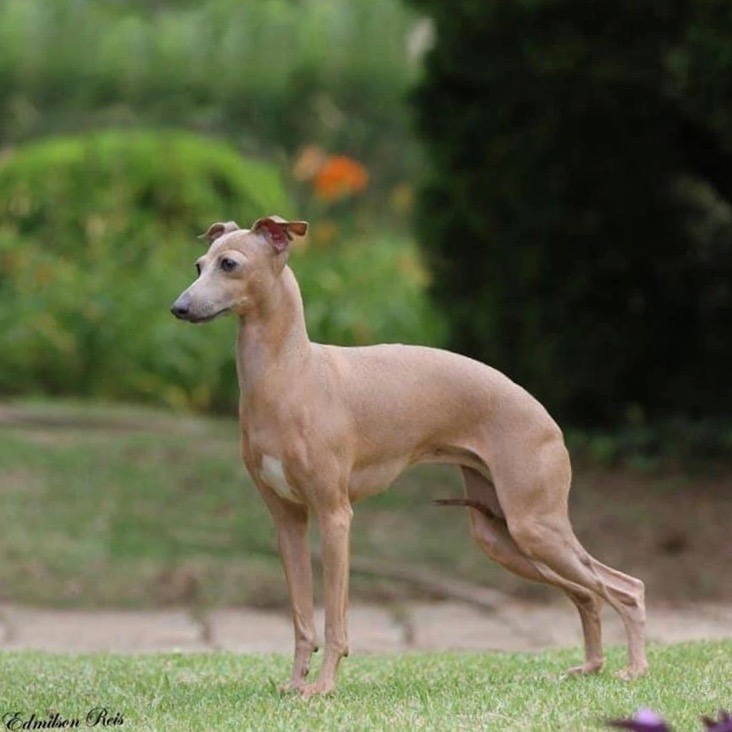Breeds
Italian Greyhound

GROUP 1 - TOYS
Brief History
The Italian Greyhound is possibly from the times of the Egyptian Pharaohs; drawings of small greyhounds, very similar to the Italian Greyhound can be found immortalised in the hieroglyphics adorning the walls of their tombs. As the gargantuan Roman Empire sprawled its way to Egypt, these slender dogs made their way to the Italian homes of returning centurions and soldiers, who presented them as gifts to the Caesars and their entourage. Popular for centuries throughout Europe, the Italian Greyhound eventually reached England and was an adornment to the courts of the Stuarts and Queen Victoria. As a member of the coursing or sight hound group, the Italian Greyhound was possibly used in ancient times for hunting small game as well as a lapdog and companion duties.
Average Life Span
When considering a dog, please realise that you are taking it on for its lifetime.
The average life span is 13 to 14 years.
Temperament
Above all, the Italian Greyhound likes the good life and believes he was destined for an existence of luxury. The Italian Greyhound is vivacious, alert, highly intelligent and very affectionate of his owners. Do not, however, expect them to be quite so bold when they first meet visitors. He is easy to train and is a quick learner.
General Breed Description
Italian Greyhounds superficially resemble Greyhounds in miniature, just more slender and more delicate. No other breed in dogdom can match them for refinement, grace and elegance. The Italian Greyhound presents the picture of possessing great length of leg, body and head, whilst exhibiting sleek curving lines, attributes which in fact are common to all coursing hounds. He has a fine, supple, sleek and glossy coat that comes in many colours including; black, blue, cream, fawn, red, and white, together with particoloured.
Coat and Care Requirements
Well-fenced gardens are essential as there is a high risk of injury if allowed the Italian Greyhound is allowed to roam free. Ideally, they are a house dog with access to the garden via a ‘doggy door’. A warm bed or basket is a must, away from draughts, containing a soft blanket or rug, as most Italian Greyhounds love to wrap themselves up in their blanket, even in the hottest weather. He can become a ‘lounge-lizard’ in the winter. The thin, glossy coat is easy to keep clean, sheds very little hair and is virtually odourless. After bathing, care should be taken to make sure they are thoroughly dried. Some Italian Greyhounds do feel the cold and then a coat is recommended for cold weather, especially when outdoors. The Italian Greyhound is a lightly built dog and should not be allowed to become too fat. The breeders should be able to provide a recommended diet sheet. The Italian Greyhound enjoys being taken for walks, as much for the mental stimulation as for the exercise.
Size
Height: 32 to 38cms (12.5 to15 ins).
Weight: 3.6 to 4.5kgs.
Health
All breeds have individual health issues. When speaking to breeders it is recommended you enquire about the breed’s health and what health testing the breeder does. The Italian Greyhound is generally a healthy breed however, health conditions do occur occasionally. These may include health conditions such as PRA, autoimmune problems, Legg-Calve-Perthes disease and hypothyroidism. Although the Italian Greyhound is not as delicate as he looks, care must be taken to avoid hazardous situations that might result in a broken leg.
Suitability
The Italian Greyhound will suit those wanting a loving and devoted canine companion, but they can be needy. They are better with older children, as accidents can occur. They are happiest when on the sofa and cocooned under a blanket, as they hate cold draughts. They will need a warm coat to wear in the colder months. Exercising will require a regular walk on a suitable lead or a good run in a well fenced yard. Due to their curious natures they can be escape artists and will dig under a fence or find even the smallest space to squirm through to investigate what might lay yonder.
In Conclusion
Now you know a little more about this breed. If you have decided this is the dog for you and wish to investigate further, please contact the Breed Club or Dogs Victoria. They will be able to give you information about available puppies and also suggest dog events where you can see the breed and speak to breeders. In this way you will gain a better perspective of the breed and its needs. With any breed of dog, it is important to research and determine suitability for your lifestyle before committing to a puppy which will be a part of your family for many years to come.
Whilst many breeds are recommended for families, it is imperative that when children are with dogs they are supervised at all times. Basic obedience training is a vital part of dog ownership.
Dogs Victoria is about the responsible ownership of all dogs and in particular, the preservation of pure breeds.
Link to Dogs Australia Breed Standard: https://dogsaustralia.org.au/breed/detail/24
Breeders




